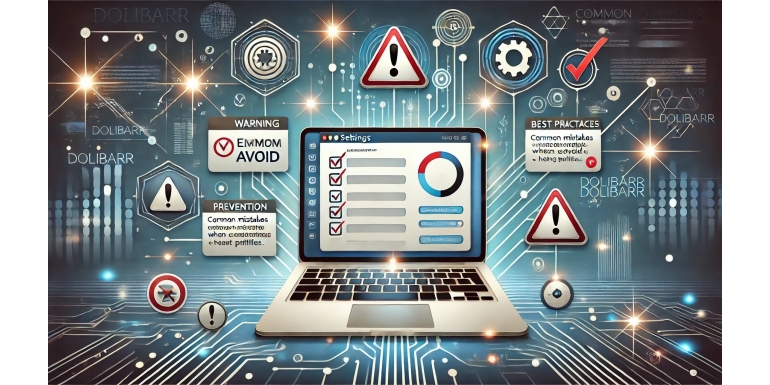
Introduction
Dolibarr is an open-source ERP and CRM solution that enables businesses to efficiently manage their commercial, accounting, and customer relationship operations. Its flexibility and extensive features make it a popular choice for small and medium-sized enterprises. However, improper configuration can lead to performance, security, and efficiency issues.
In this article, we will explore the most common mistakes to avoid when configuring Dolibarr to optimize its use and ensure smooth and secure operation.
1. Choosing the Wrong Hosting Infrastructure
1.1. Undersized Server
Many businesses install Dolibarr on a low-power server, which can result in slowdowns and errors. It is recommended to have a server with at least 4 GB of RAM and a powerful processor to ensure smooth performance.
1.2. Neglecting Server Security
Failing to secure your server exposes Dolibarr to potential attacks. It is essential to:
-
Install a firewall and antivirus.
-
Restrict SSH access to specific IP addresses.
-
Use an SSL/TLS certificate to secure data exchanges.
1.3. Choosing the Wrong Hosting Option
Shared hosting can cause performance issues. Opt for a dedicated server or a VPS for more control and resources.
2. Poor Installation and Updating Practices
2.1. Not Checking Technical Requirements
Before installing Dolibarr, ensure that the server meets the official prerequisites, including:
-
PHP 7.4 or higher
-
MySQL 5.6+ or PostgreSQL 9.4+
-
Necessary PHP extensions (GD, cURL, mbstring, etc.)
2.2. Installing an Outdated Version
Using an older version can expose security vulnerabilities and lack recent features. Always check for the latest stable version on Dolibarr.org.
2.3. Failing to Update Regularly
Dolibarr is updated frequently, and failing to update the system can lead to bugs, security vulnerabilities, and incompatibility with certain modules. Enable update notifications and always back up data before updating.
3. Database Configuration Mistakes
3.1. Not Securing Database Access
-
Never use the root user for Dolibarr.
-
Create a dedicated user with limited permissions.
-
Restrict database access to authorized IP addresses only.
3.2. Poor Backup Management
Failing to set up automatic backups can be disastrous in case of failure. Use mysqldump or an external backup tool for regular backups.
3.3. Lack of Optimization
A poorly optimized database can slow down Dolibarr. Enable query indexing, regularly clean obsolete entries, and use InnoDB instead of MyISAM for better performance.
4. User and Permission Management Errors
4.1. Granting Excessive Permissions to Users
Giving employees too many privileges increases the risk of accidental modifications or data leaks. It is best to follow the principle of least privilege.
4.2. Not Enabling Strong Authentication
To protect Dolibarr access, it is recommended to use:
-
Strong passwords.
-
Two-factor authentication (2FA).
-
IP-based access restrictions.
4.3. Failing to Deactivate Inactive Accounts
Former employees or inactive users should be deleted or disabled to prevent security breaches.
5. Poor Management of Modules and Extensions
5.1. Installing Too Many Modules
Activating too many modules can slow down Dolibarr and create conflicts. Keep only essential modules and disable unused ones.
5.2. Using Unofficial, Outdated Modules
Some modules found online are not maintained and may contain security vulnerabilities. Always download modules from Dolistore.
5.3. Failing to Configure Modules After Installation
Each module has specific settings. Omitting configuration can lead to malfunctions and incorrect report generation.
6. Errors in Invoice and Quote Management
6.1. Incorrect Tax Configuration
Tax rules vary by country. Ensure that:
-
VAT and other taxes are properly defined.
-
Exchange rates are updated if you operate internationally.
6.2. Errors in Invoice Numbering
Poor invoice numbering management can cause accounting issues. Set up a unique numbering scheme and avoid manual modifications.
6.3. Not Using Invoice Status Tracking
Dolibarr allows tracking invoice statuses (pending, paid, canceled). Failing to use these statuses can lead to payment management errors.
7. Poor Security and Access Management
7.1. Not Enabling HTTPS
Without an SSL/TLS certificate, all communications with Dolibarr are unencrypted, posing a significant hacking risk.
7.2. Not Monitoring Logs
Logs help detect suspicious behavior. Regularly enable and monitor:
-
Access logs.
-
Error logs.
-
Failed login attempts.
7.3. Lack of a Disaster Recovery Plan
Businesses should anticipate issues by implementing a disaster recovery plan with external backups and regular restoration tests.
Conclusion
Dolibarr is a powerful tool, but misconfiguration can lead to performance and security issues. Avoiding these common mistakes will allow you to leverage Dolibarr’s full potential, ensuring efficient and secure business management.
Take the time to properly configure your Dolibarr instance from the start and apply best practices to optimize its long-term use!
